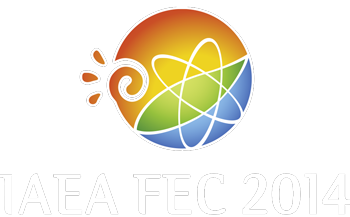Speaker
Ms
Laila El-Guebaly
(USA)
Description
A Fusion Nuclear Science Facility (FNSF) could play an important role in the development of fusion energy by providing the nuclear environment needed to develop fusion materials and components. The spherical tokamak (ST) is a leading candidate for an FNSF due to its potentially high neutron wall loading and modular configuration. A key consideration for the choice of FNSF configuration is the range of achievable missions as a function of device size. Possible missions include: providing high neutron flux (1-2MW/m2) and fluence (3-6MWy/m2), demonstrating tritium self-sufficiency (tritium breeding ratio TBR ≥ 1), and demonstrating electrical self-sufficiency. All of these missions must also be compatible with a viable divertor, first-wall, and blanket solution. During the past two years, U.S. studies have for the first time developed ST-FNSF configurations simultaneously incorporating: (1) a blanket system capable of TBR ~ 1, (2) a poloidal field (PF) coil set supporting high elongation and triangularity for a range of li and normalized beta values consistent with NSTX/NSTX-U previous/planned operation, (3) a long-legged / Super-X divertor analogous to the planned MAST-U divertor which substantially reduces projected peak divertor heat-flux and has all outboard PF coils outside the vacuum chamber and as superconducting to reduce power consumption, and (4) a vertical maintenance scheme in which blanket structures and the centerstack (CS) can be removed independently. Progress in these ST-FNSF mission vs. configuration studies including dependence on plasma major radius R0 for a range R0 = 1 – 1.6m will be described. TRANSP/NUBEAM calculations of negative neutral beam heating and current drive scenarios will also be described.
| Country or International Organisation | USA |
|---|---|
| Paper Number | FNS/1-1 |
Author
Dr
Jonathan Menard
(Princeton Plasma Physics Laboratory)
Co-authors
Dr
Ali Zolfaghari
(Princeton Plasma Physics Laboratory)
Dr
Brent Covele
(University of Texas - Austin)
Dr
Charles Kessel
(Princeton Plasma Physics Laboratory)
Mr
Charles Neumeyer
(Princeton Plasma Physics Laboratory)
John Canik
(Oak Ridge National Laboratory)
Ms
Laila El-Guebaly
(USA)
Dr
Lucas Mynsberge
(University of Wisconsin - Madison)
Dr
Masayuki Ono
(PPPL/Princeton University)
Dr
Michael Kotschenreuther
(University of Texas - Austin)
Dr
Prashant Valanju
(University of Texas)
Dr
Rajesh Maingi
(Princeton Plasma Physics Laboratory)
Dr
Robert Woolley
(Princeton Plasma Physics Laboratory)
Dr
Roger Raman
(University of Washington)
Dr
Stanley Kaye
(Princeton Plasma Physics Laboratory, Princeton University, Princeton NJ, 08543 USA)
Dr
Stefan Gerhardt
(Princeton Plasma Physics Laboratory)
Dr
Steven Sabbagh
(Columbia University)
Prof.
Swadesh Mahajan
(University of Texas - Austin)
Mr
Thomas Brown
(Princeton University, Princeton Plasma Physics Laboratory)
Dr
Vsevolod Soukhanovskii
(Lawrence Livermore National Laboratory)

